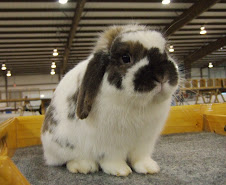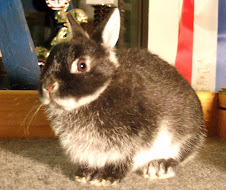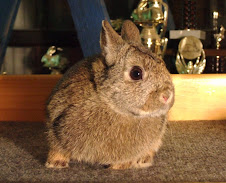While we're waiting to find out if our rabbits sell, here's the results of the last big breeding:
Thomas' Mr. A (black) to:
Tank's Nico (himi)- produced two- one black, one himi
Tank's Sapphire (choc. chin)- produced one chesnut agouti
Tank's Bacchus (opal) to:
Tank's Eris (black otter)- X
Tank's Habiba (black)- produced one chocolate (!)
Tank's Milkshake (REW- yay,'Shake!) to:
Tank's Oseya (sable)- produced one REW, one sable marten
Tank's Tizaqueena (chocolate)- X
Tank's Dunkirk (chin) to:
Tank's Liberty (chestnut)- produced three chestnut agoutis
Tank's Karolina (himi)- X
Tank's Hjalmir (black otter)to:
Tank's Rashida (chocolate)- produced two blacks
Tank's Sesheta (black otter)- X
Tank's Jupiter (chocolate himi) to:
Tank's Shiara (black)- X
Tank's Chatter (black)- prodcued one black, one blue
The Rabbit Tank Blog
news from our rabbitry in Valley Mills, TX... Championship-Quality Netherland Dwarfs & Holland Lops
Monday, June 7, 2010
Thursday, June 3, 2010
MUST SELL OUT- Unique Opportunity
Asking $600 for completye package of rabbits, cages, nestboxes, show tables, supplies. This is a championship-quality line of NDs we've been working hard on for over 15 years. Must sell due to a new job & I can't move the rabbits or there's no way I'd want to lose them.
6 ND bucks
14 ND does
13 ND babies in nestboxes
18 18"x24" cages (units of 2)
18 24"x24" cages (units of 2)
13 ND nextboxes
2 HL nextboxes
18 show carriers (most 4-hole)
show table
1 show dolley
various feed & water bowls
MBT
6 ND bucks
14 ND does
13 ND babies in nestboxes
18 18"x24" cages (units of 2)
18 24"x24" cages (units of 2)
13 ND nextboxes
2 HL nextboxes
18 show carriers (most 4-hole)
show table
1 show dolley
various feed & water bowls
MBT
Labels:
cages,
pet rabbits,
rabbit supplies,
rabbits for sale,
show rabbits,
show tables
Thursday, April 29, 2010
History of the Netherland Dwarf rabbit
Interesting brief history of Netherland Dwarfs, from Amick's Netherland Dwarfs website:
Netherland dwarfs go back to the early 1880,s in England. Some litters of Dutch rabbits with white colored kits with red eyes, a short cobby body, and a soft coat. They were given the name "Polish". These mutations reproduced and through line breeding more of these red eyed white rabbits appeared. The new breed was first exhibited in 1884 in England and was exported to Germany. In Germany a standard was created which was similar to our current dwarf standard. These white rabbits were crossed with small wild rabbits. This improved type and resulted in agouti colored rabbits. The next generation resulted in black rabbits and finally the whites reappeared.
Until the late 1930's color choice was limited to Blue-eyed whites and Red eyed whites. At this time breeders crossed the REWs with other breeds to get different colored dwarfs. After years of breeding, the result of colored dwarfs that resembled our present day animals were given a standard in 1940.
At the beginning of the First World War, the blue-eyed white made its appearance in the province of Saxony. As to how the blue-eyed white was first bred, little is known. These animals were larger in bone structure, longer in body, and had a more harsh, fly back coat than did the red-eyed whites.
After the second world war the Netherland Dwarf arrived in England. On October 13, 1949 fanciers formed the Netherland Dwarf Club in England. Popularity grew quickly and in 1950 the British Rabbit Council gave them official recognition. A total of 18 rabbits were entered in their first dwarf show.
Netherlands come to the US:
As early as 1965 Netherland Dwarfs were imported to both the US and to Canada to improve the Polish breed, or as a curiosity. In 1969 Darrell Bramhall met with English fancier Jack Turnbull and began a life long interest in Netherland Dwarfs. Mr. Turnbull had brought a number of Dwarfs over from England and offered some of them to him. Mr Bramhall suggested that they form a specialty club to promote and encourage the breeding and showing of Netherland Dwarfs in the US. He also began work on a standard for dwarfs to be accepted by the ARBA. The English standard formed the basis and a few minor changes were made. The standard was presented to ARBA at the 1969 convention in Calgary Canada. At this show Mr. Turnbull was responsible for exhibiting the first required showing of Dwarfs at this Convention. There were a total of 6 dwarfs shown by 2 exhibitors. Albert Reurs, a Dutchman residing in Ontario, Canada, was the other exhibitor. At this show the ARBA Board of Directors accepted the proposed Standard of Perfection for the Netherland Dwarf rabbit. With this ruling, the Dwarfs could be shown as a recognized breed at all ARBA shows.
Interest in Dwarfs spread rapidly during the first year, as many more Dwarfs were imported from England and Holland, and many new breeders became interested in the breed. At the 1970 ARBA Convention & Show the small beginning of only 6 Dwarfs at the previous Convention rose to 85 Dwarfs that year.
In the spring of 1971 the ANDRC held its first National Netherland Dwarf Show at Montpelier, Ohio. There were 85 Dwarfs shown by 26 exhibitors.
The American Netherland Dwarf Rabbit Club, the proposed specialty club for dwarfs, was granted an ARBA charter on Jan. 15, 1970. During this time a club newsletter called Netherland News was created. Membership saw rapid growth during this time to 550 members in 1973 and over 1200 by the end of 1974. The newsletter name was changed to Dwarf Digest. Today the ANDRC is considered one of the best and largest specialty clubs in ARBA and offers many services to it's membership. The Dwarf Digest and club guidebook offer invaluable information to both new breeders and old timers. The ANDRC also has a scholarship program for youth members.
Varieties include Ruby Eyed White, Blue Eyed White, Black, Blue, Chocolate, Lilac, Chestnut, Opal, Lynx, Chinchilla, Squirrel, Siamese Sable, Siamese Smoke Pearl, Sable Point, Tortoise Shell, Tan (Black, Blue, Chocolate & Lilac), Silver Marten (Black, Blue, Chocolate & Lilac), Sable Marten, Smoke Pearl Marten, Otter (Black, Blue, Chocolate & Lilac), Orange, Fawn, Himalayan (Black, Blue, Chocolate & Lilac) and Steel and recently a Broken variety.
The Dwarf body type is short, compressed, neck less, and demonstrates good rounded contours with a well-filled rump. The feet are quite short and close together. The tail is small and is carried tightly against the rump. The weight for a full grown animal may range from 1-1/2 to 2-1/2 pounds. The pelt demonstrates a roll-back characteristic. The head profile is circular in contour with a wide forehead, strongly curved nose bone, and strong, well developed jaws and skull. The ears are short, worn stiffly and close together . . . not necessarily touching and go gradually to a lightly rounded point. The maximum limit is 2-1/2 inches, but a balanced appearance is necessary. The ears have very dense, but short hairs.
Netherland dwarfs go back to the early 1880,s in England. Some litters of Dutch rabbits with white colored kits with red eyes, a short cobby body, and a soft coat. They were given the name "Polish". These mutations reproduced and through line breeding more of these red eyed white rabbits appeared. The new breed was first exhibited in 1884 in England and was exported to Germany. In Germany a standard was created which was similar to our current dwarf standard. These white rabbits were crossed with small wild rabbits. This improved type and resulted in agouti colored rabbits. The next generation resulted in black rabbits and finally the whites reappeared.
Until the late 1930's color choice was limited to Blue-eyed whites and Red eyed whites. At this time breeders crossed the REWs with other breeds to get different colored dwarfs. After years of breeding, the result of colored dwarfs that resembled our present day animals were given a standard in 1940.
At the beginning of the First World War, the blue-eyed white made its appearance in the province of Saxony. As to how the blue-eyed white was first bred, little is known. These animals were larger in bone structure, longer in body, and had a more harsh, fly back coat than did the red-eyed whites.
After the second world war the Netherland Dwarf arrived in England. On October 13, 1949 fanciers formed the Netherland Dwarf Club in England. Popularity grew quickly and in 1950 the British Rabbit Council gave them official recognition. A total of 18 rabbits were entered in their first dwarf show.
Netherlands come to the US:
As early as 1965 Netherland Dwarfs were imported to both the US and to Canada to improve the Polish breed, or as a curiosity. In 1969 Darrell Bramhall met with English fancier Jack Turnbull and began a life long interest in Netherland Dwarfs. Mr. Turnbull had brought a number of Dwarfs over from England and offered some of them to him. Mr Bramhall suggested that they form a specialty club to promote and encourage the breeding and showing of Netherland Dwarfs in the US. He also began work on a standard for dwarfs to be accepted by the ARBA. The English standard formed the basis and a few minor changes were made. The standard was presented to ARBA at the 1969 convention in Calgary Canada. At this show Mr. Turnbull was responsible for exhibiting the first required showing of Dwarfs at this Convention. There were a total of 6 dwarfs shown by 2 exhibitors. Albert Reurs, a Dutchman residing in Ontario, Canada, was the other exhibitor. At this show the ARBA Board of Directors accepted the proposed Standard of Perfection for the Netherland Dwarf rabbit. With this ruling, the Dwarfs could be shown as a recognized breed at all ARBA shows.
Interest in Dwarfs spread rapidly during the first year, as many more Dwarfs were imported from England and Holland, and many new breeders became interested in the breed. At the 1970 ARBA Convention & Show the small beginning of only 6 Dwarfs at the previous Convention rose to 85 Dwarfs that year.
In the spring of 1971 the ANDRC held its first National Netherland Dwarf Show at Montpelier, Ohio. There were 85 Dwarfs shown by 26 exhibitors.
The American Netherland Dwarf Rabbit Club, the proposed specialty club for dwarfs, was granted an ARBA charter on Jan. 15, 1970. During this time a club newsletter called Netherland News was created. Membership saw rapid growth during this time to 550 members in 1973 and over 1200 by the end of 1974. The newsletter name was changed to Dwarf Digest. Today the ANDRC is considered one of the best and largest specialty clubs in ARBA and offers many services to it's membership. The Dwarf Digest and club guidebook offer invaluable information to both new breeders and old timers. The ANDRC also has a scholarship program for youth members.
Varieties include Ruby Eyed White, Blue Eyed White, Black, Blue, Chocolate, Lilac, Chestnut, Opal, Lynx, Chinchilla, Squirrel, Siamese Sable, Siamese Smoke Pearl, Sable Point, Tortoise Shell, Tan (Black, Blue, Chocolate & Lilac), Silver Marten (Black, Blue, Chocolate & Lilac), Sable Marten, Smoke Pearl Marten, Otter (Black, Blue, Chocolate & Lilac), Orange, Fawn, Himalayan (Black, Blue, Chocolate & Lilac) and Steel and recently a Broken variety.
The Dwarf body type is short, compressed, neck less, and demonstrates good rounded contours with a well-filled rump. The feet are quite short and close together. The tail is small and is carried tightly against the rump. The weight for a full grown animal may range from 1-1/2 to 2-1/2 pounds. The pelt demonstrates a roll-back characteristic. The head profile is circular in contour with a wide forehead, strongly curved nose bone, and strong, well developed jaws and skull. The ears are short, worn stiffly and close together . . . not necessarily touching and go gradually to a lightly rounded point. The maximum limit is 2-1/2 inches, but a balanced appearance is necessary. The ears have very dense, but short hairs.
Labels:
netherland dwarf,
netherland dwarfs,
rabbits
Wednesday, April 28, 2010
Pink Moon- TIME FOR OUR SPRING BREEDING!

The full moon each April is known as Seed Moon, Waking Moon, Sprouting Grass Moon, Egg Moon and Pink Moon, per the Farmer's Almanac.
"This name came from the herb moss pink, or wild ground phlox, which is one of the earliest widespread flowers of the spring. Other names for this month’s celestial body include the Full Sprouting Grass Moon, the Egg Moon, and among coastal tribes the Full Fish Moon, because this was the time that the shad swam upstream to spawn."
I like that. Our rabbits certainly sprung springish last night & this morning- I think this may be the fastest breeding ever in the history of ever at The Rabbit Tank! Here's the rundown:
Thomas' Mr. A (black) to:
Tank's Nico (himi)
Tank's Sapphire (choc. chin)
Tank's Bacchus (opal) to:
Tank's Eris (black otter)
Tank's Habiba (black)
Tank's Milkshake (REW- yay,'Shake!) to:
Tank's Oseya (sable)
Tank's Tizaqueena (chocolate)
Tank's Dunkirk (chin) to:
Tank's Liberty (chestnut)
Tank's Karolina (himi)
Tank's Hjalmir (black otter)to:
Tank's Rashida (chocolate)
Tank's Sesheta (black otter)
Tank's Jupiter (chocolate himi) to:
Tank's Shiara (black)
Tank's Chatter (black)
Our goals include producing a quality black buck, does of all colors but especially black otter & agouti patterns and, as always, fun colored coats on quality animals!
Comments?
MBT
Thursday, March 25, 2010
More Show Table Fun!
Amara & Garron introducing Tank's Dunkirk, our young Chinchilla Senior Buck.
MBT
Tuesday, March 16, 2010
Springtime & Love Is In the Air!
Spring is in the air at The Rabbit Tank! Full information on our latest breeding coming to this space soon...
Tuesday, March 9, 2010
Subscribe to:
Posts (Atom)
















